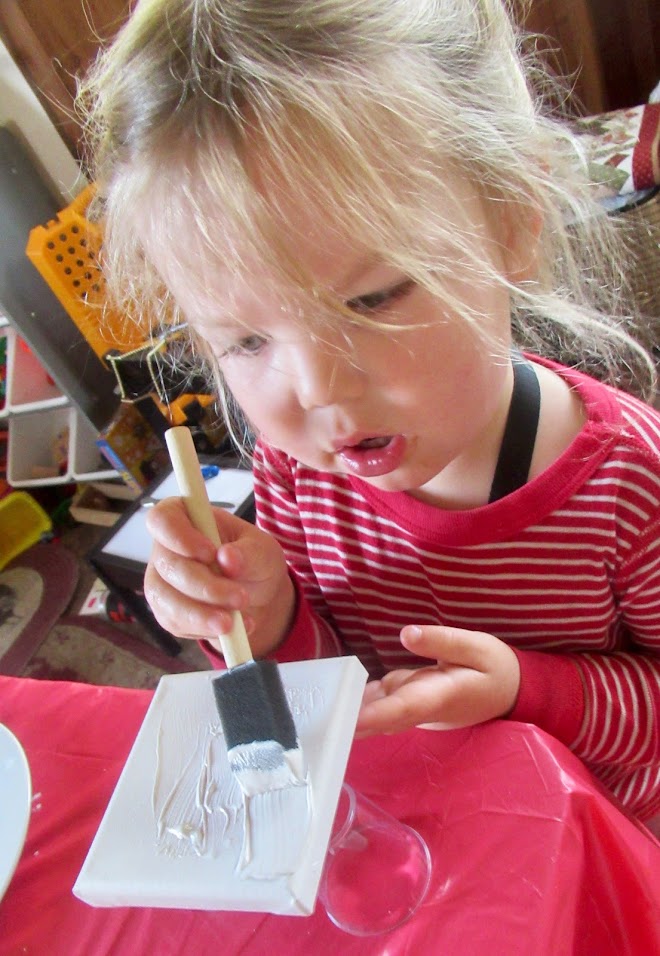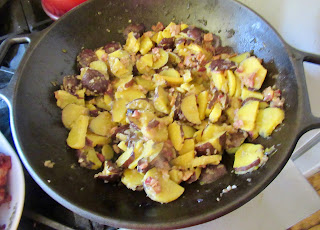Hash browns and a chili omelet were the breakfast favorites in this house when the boys were growing up. The chili omelet consisted of heating up a can of chili, scrambling eight or ten eggs, pouring the chili over the eggs and covering it with grated cheese, and then serving it alongside crispy hash browns.
I’m talking about a huge skillet filled most of the way up with grated, [preferably] Russet potatoes, in avocado oil or the oil of your choice. There are recipes that create hash brown patties with flour, egg and various spices, but that’s not what I aim for. I want large quantities with no ingredients except potatoes, oil and salt/pepper.
To begin I leave the skin on all potato dishes because the skin of the potato is high in fibre, potassium, vitamin C and vitamin B, and adds to the taste and texture of cooked potatoes. I just fill a stainless steel bowl with water and soak the potatoes for a minute or two before giving them a good scrub-down. It’s a matter of personal choice so do what works for you.
I get my skillet heating over a medium to high fire after I have grated the potatoes, while I rinse them under fresh, running water. If the goal is crispy hash browns, I let the water wash through them until all of the starch is gone and the water is clear. Otherwise, a quick rinse is more than sufficient.
How much oil? There is no right or wrong answer to this question-only a matter of personal preference. Too much results in oil-soaked, soggy browns; not enough will never produce the crispiness most of us like.
I put enough oil (or bacon grease) in the skillet to cover to a one-quarter-inch depth. That way, there is still some on the bottom of the pan when you flip the hash browns over to cook the second side. I let the oil heat up so that when I put my open hand over the oil, palm down, it is plenty hot but not smoking hot. If it gets to that point, either remove the skillet and let it cool down, or just turn the burner off for a minute or two before proceeding.
I try to get all excess water out of the grated potatoes, so as to minimize the noise and potential spatter of hot oil as water droplets hit the pan. I salt and pepper the browns right away and cover the skillet, being careful to stay near until it is time to flip them over. I also reduce the fire under the skillet to medium, so as to prevent scorching.
Before covering them, I use my heavy metal spatula to divide the hash browns in half first, and then quarters, to make it easier to flip them over. This also allows me to peek under each of the frying fourths to check on color of the browns to determine when it is best to flip them over.
How long? In my head I figure it is never more than ten minutes on the first side, and not even that long on the flip side, depending on your personal taste. You always have the option of taking a taste-test.
It’s a tough job but someone’s gotta do it.
Go-Jo’s
 |
I drain the water and as best I can, pat the potatoes dry before putting them into an empty, dry bowl so as to be able to stir in olive oil, salt and pepper. For a dozen small-to-medium, cut-up potatoes, I would use one-quarter cup of oil, one teaspoon of salt and a half-teaspoon of black pepper, subject to tasting. I’d stir the bowl of potatoes until I felt they were evenly covered and then lay them out on the cookie sheet so that there is breathing space around each of them. This allows for more even cooking.
The hotter the oven, the more likely you are to get them to crisp up. But you also have to keep an eye on them after 35 or 40 minutes if you are blazing along at 450 degrees. I like 400 degrees and I start checking after 40 minutes. You can also precook these kids and put them back into a hot oven for ten minutes and they will heat up nicely.
German potato salad
German potato salad was a classic family favorite growing up on Fellowship Street in SoCal. No mayonnaise, no boiled eggs, no pickles: Is nothing sacred? Diabolically simple (see recipe), this dish is served either warm or at room temperature, and complements barbecued meat the way hash browns go with chili omelets.
Leaving the skins on, I cover the pan and steam small to medium potatoes (or larger potatoes cut into uniform chunks) until an ice pick indicates they are done. That is usually between 20 and 25 minutes, depending on whether you like your potatoes slightly al dente or really soft. The advantage to steaming potatoes is that they don’t fall apart the way boiling potatoes will sometimes do. I find it easier to gauge whether the potatoes are done or not when I steam them.
When they are done, I fill the cooking pot with cold water to help prevent the potatoes from continuing to cook. After they are cooled off, I slice them up thinly and set them to one side while I dice up my bacon and get it on the stovetop. If you like bigger chunks of potato, then cut them the width you like.
Once the bacon is close to being done, I add the diced onions, garlic and parsley and sauté them until the onions are cooked through. Though it’s not in the “recipe,” I generally break the glaze from the bacon with wine, something like a quarter-cup.
Once the onions and garlic are cooked, I add the vinegar, maple syrup mustard and salt/pepper, and let everything simmer together for a minute or two to let the flavors blend. I then pour the mixture over the potatoes and mix it all together thoroughly, and serve it at room temperature.
French fries
Everyone agrees: Home-grown French fries are the best. I make them with the skins on, of course, but sometimes I like big beefy fries and sometimes I like shoestrings. They’re made the same way; it’s all in how you cut them up.
If you struggle with using a lot of oil, remember that oil for fries can be reused, though three or four times is as far as I take it. Still, it helps to not have to throw the oil away each time after using it.
Scrubbing the potatoes and cutting them up is the first step, after which I put them under cold water until they are ready to go into the Dutch oven. I use the big Dutch oven because of how it absorbs the heat from the stove and distributes it back through the oil. The fries cook much more efficiently in the Dutch oven than they do in the sauce pan I use for making popcorn.
Just as when you make hash browns, the oil should be sizzling hot, but not so hot that it smokes. I test-drive the oil by putting one fry in and seeing how it responds. If it sounds like a bomb going off, the oil is too hot. If nothing happens, the oil is not hot enough. Once you feel the oil is perfect, dump the fries in carefully, after draining them and patting them dry as best you can.
Average time to cook them through is ten minutes per batch, though shoestrings take less time. I use a slotted spoon and taste-test one fry when I think I am getting close, and when they are ready to come out, I place them on cooling racks on top of paper towels. You can also make fries in advance and pop them back into a preheated oven for seven to ten minutes to freshen them up, but remove the paper towels before putting the fries back in the oven.
I serve them with my homemade ketchup.
You don’t have to be Irish to love potatoes, but it helps. Think of it as a marriage made in heaven, and pass those mashed potatoes over here, will you please?























No comments:
Post a Comment